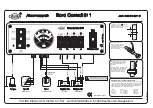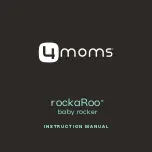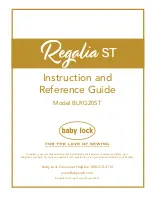
APOLLO LOW PRESSURE SUPPLIED-AIR RESPIRATOR
Page 6
HELMET MODEL 20
© 2011 CLEMCO INDUSTRIES CORP.
www.clemcoindustries.com
Manual No. 21991
3.3
Breathing Tube Assembly
CAUTION
Note the directional flow arrows on the labels at
both ends of the breathing tube. The flow
arrows indicate the direction of air flow to the
helmet. Flow arrows must point toward the
helmet. Failure to properly attach the breathing
tube may damage the tube's acoustical foam,
which will block air flow, or it may increase
noise levels beyond OSHA limits.
3.3.1
The breathing tube has a clamped-on end and a
molded-on end. Attach the clamped-on end to the
threaded air inlet fitting at the back of the helmet as
shown in Figure 2. Do not over-tighten; hand-tight is
sufficient.
3.3.2
Attach the molded-on swivel connector to the
constant-flow connector.
Figure 2
CAUTION
Use the handle to carry or hang the respirator.
Never hold, carry or hang the respirator by the
breathing tube. Mishandling the respirator in
this manner may damage the tube or helmet
inlet. Any leaks or breaks in the breathing tube
will alter the air flow through the respirator and
affect user’s safety and comfort.
3.4 Respirator
Hose
WARNING
OSHA regulations 29 CFR 1910 and 29 CFR
1926 require that respirator air line couplers be
incompatible with air lines for non-respirable
use. This incompatibility prevents inadvertent
supply of respirators with potentially
hazardous, non-respirable gases or oxygen. It
is the employer's or facility owner's
responsibility to comply with the regulation.
3.4.1
Respirator hose must be NIOSH-approved
Clemco 1/2
"
ID respirator hose.
3.4.2
If longer hose is required, it must be a NIOSH-
approved Clemco 1/2
"
respirator hose extension. Use
50-foot or 100-foot Clemco respirator hoses in any
combination as noted in the table in Section 4.2, not to
exceed 300 ft. or three individual hose lengths.
3.4.3
Attach the female disconnect end of the
respirator hose to the constant-flow connector. The male
end attaches to the ambient air pump.
3.5
CMS-3 CO Monitor Option, Respirator Mounted
The Clemco supplied air respirator model Apollo 20 LP is
NIOSH approved with the accessory CMS-3 personal
carbon monoxide alarm, but NIOSH has not evaluated the
function of the CMS-3 personal carbon monoxide alarm.
3.5.1
Open the lens frame and remove the lenses per
Section 9.2.
3.5.2
Don the helmet and place monitor on one of the
side walls of the window extension, positioning it to make
sure the alarm light is visible from inside the helmet.
3.5.3
Mark the location and remove the monitor and
helmet.
3.5.4
Remove backing from the Velcro
®
hook tape and
adhere it at the marked location (the loop tape adheres to
the monitor). Attach the monitor and make sure the
monitor’s alarm lights are visible from inside the helmet.
3.5.5
Remove the monitor and prepare it for operation
per instructions supplied with the monitor.
3.5.6
Replace the lenses and lens frame assembly.
3.5.7
After the initial setup is done, remove and
reattach the monitor from inside the helmet. Remove the
monitor to do any service or calibration, including turning
Connect the molded-on
swivel to the constant-flow
connector
Breathing Tube Assembly
Connect the clamped-on
swivel to the helmet’s
inlet fitting.
Handle
Constant-Flow Connector






































